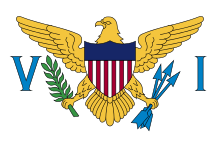Morris Fidanque de Castro
Morris Fidanque de Castro (1902 – December 9, 1966) was the first native Governor of the United States Virgin Islands and a lifetime government servant for the territory.
Early life
De Castro was born in Saint Thomas and attended Roman Catholic High School of St. Thomas, despite the fact that he was Jewish. His father was a merchant. Immediately after graduating high school, de Castro obtained a job working as a clerk in the island's sanitation office. Over the years, de Castro remained in government and gradually rose through the ranks until he was appointed as the Commissioner of Finance in 1934.
In 1939, de Castro was briefly made acting governor while Lawrence William Cramer was attending hearings in Washington, D.C.. This role usually fell to the government secretary, such as Robert Herrick in 1935, but de Castro given the position instead. During his brief tenure, the United States Virgin Islands was honored by an "unofficial" state visit by Frederick IX of Denmark, then still the Crown Prince, and his wife, Ingrid of Sweden. Over the years, de Castro continued to be a prominent choice whenever an acting governor was necessary.
In 1944, he was promoted from Commissioner of Finance to an assistant to Governor Charles A. Harwood. In 1945, he was made government secretary and held that position until he was appointed full governor by President Harry S. Truman on February 28, 1950. (He was inaugurated March 4.) Though he was aware that he was under consideration for the position (he had been again made acting governor in the interim), he did not campaign for it though he indicated that he would take it, if offered. De Castro's appointment was considered by many as a symbol that the United States wanted increased self-government for its territories.
Governor of the United States Virgin Islands
As governor, de Castro worked to increase the self-sufficiency of the islands. Almost immediately after his appointment, he signed a law that stiffened penalties and enforcement for discrimination in the territory, largely in response to a growing problem of private "clubs" and resorts which increasingly catered exclusively to mainland whites, rather than locals. He also campaigned with the federal government to allow the territory to keep the tax revenue collected on the export of rum. Previously, this had been collected by the federal government to offset the territory's old debts. He also sought to allow the territory to elect its own governor.
However, during his term, de Castro was forced to make concessions which were not universally popular. In 1953, he rescinded his previous remarks that the territory should elect its own governor. Instead, he clarified that it should only elect its own governors when they were self-sufficient, and not sooner. De Castro also worked to revamp the territorial's treasury. Under the old system, taxes collected in Saint Thomas could not be used to help those in Saint Croix, and vice versa. He pushed for a single unified treasury that could benefit all of the islands. This position was unpopular due to the locals not wanting the wealth of Saint Thomas being used to shore up the poorer islands.
De Castro also worked to boost tourism and industries on the island. During his term, he passed an 8-year property tax exemption for manufacturers and hotel owners, to allow industry to grow.
In 1954, de Castro resigned as governor. He was given the Department of the Interior's Distinguished Service Medal in recognition of his efforts. However, instead of retirement, he returned to work in the financial department of the territory for subsequent governors. At his death in 1966, he was the budget director for Governor Ralph M. Paiewonsky.
References
- Danish Heir at St.Thomas. New York Times. New York, N.Y.: Mar 24, 1939. pg. 23, 1 pgs
- V.I. Governor. The Washington Post. Washington, D.C.: Mar 26, 1950. pg. B4, 1 pgs
- Virgin Islands Head Would Hold Rum Tax. New York Times. New York, N.Y.: Apr 30, 1950. pg. 61, 1 pgs
- Virgin Islands' Anti-Discrimination Act. By Jean Deveaux. New York Times. New York, N.Y.: Oct 8, 1950. pg. X17, 1 pgs
- Virgin Islands Governor Balks Over Self-Rule. Jules Dubois. Chicago Daily Tribune. Chicago, Ill.: Mar 3, 1952. pg. A7, 1 pgs
- Governor Inaugurated. The Washington Post and Times Herald. Washington, D.C.: Apr 11, 1954. pg. M22, 1 pgs
- Virgin Islands Gain Over 25% In Revenue. Tri - State Defender. Memphis, Tenn.: Dec 26, 1964. Vol.X, Iss. 7; pg. 13
- Morris De Castro is Dead at 64. New York Times. New York, N.Y.: Dec 10, 1966. pg. 38, 1 pgs
External links
| Preceded by William H. Hastie |
Governor of the U.S. Virgin Islands 1949–1954 Acting-Governor until 1950 |
Succeeded by Archibald A. Alexander |
